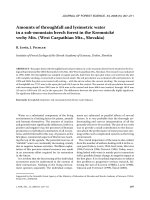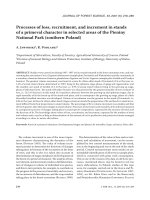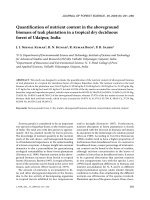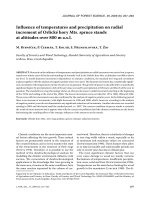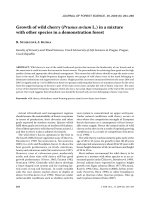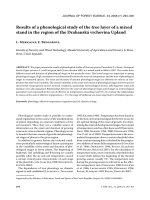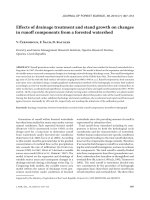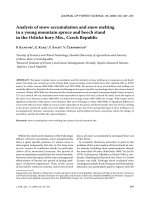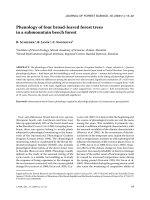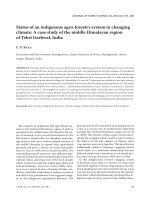Báo cáo lâm nghiệp: "Evapotranspiration of a declining Quercus robur (L.) stand from 1999 to 2001. II. Daily actual evapotranspiration and soil water reserve" potx
Bạn đang xem bản rút gọn của tài liệu. Xem và tải ngay bản đầy đủ của tài liệu tại đây (428.81 KB, 9 trang )
615
Ann. For. Sci. 62 (2005) 615–623
© INRA, EDP Sciences, 2005
DOI: 10.1051/forest:2005060
Original article
Evapotranspiration of a declining Quercus robur (L.) stand from 1999
to 2001. II. Daily actual evapotranspiration and soil water reserve
Caroline VINCKE
a
*, André GRANIER
b
, Nathalie BREDA
b
, Freddy DEVILLEZ
a
a
Unité des Eaux et Forêts, Faculté d’ingénierie biologique, agronomique et environnementale, Université Catholique de Louvain,
Croix du Sud, 2/9, 1348 Louvain-la-Neuve, Belgium
b
Équipe bioclimatologie-Ecophysiologie, INRA, Centre de recherches de Nancy, 54280 Champenoux, France
(Received 15 November 2004; accepted 2 March 2005)
Abstract – The components of actual evapotranspiration (ET) – interception (In%), tree transpiration (T) and forest floor ET – were measured
from 1999 to 2001 in a mixed stand dominated by declining pedunculate oaks. Sap flux density measurements (oaks and maple) and forest floor
ET [38] were extrapolated to season and stand scales by regressions with potential evapotranspiration (PET) and leaf area index (LAI). Stand
ET varies between 383 and 594 mm (ET/PET: 0.75–1.23). Oak transpiration (21–38% of stand transpiration) is lower than forest floor ET: forest
floor can therefore not be neglected in this stand water balance. The soil water reserve dynamics deduced from those measurements reflects the
inter-annual changes of water use. No water stress have been calculated on the 1999–2001 period, but it is suspected to have occurred
previously; together with soil constraints and caterpillar defoliation, it could in part explain the severe oak decline symptoms.
transpiration / evapotranspiration / Quercus robur (L.) / forest decline / soil water reserve
Résumé – Évapotranspiration d’un peuplement de chêne pédonculé (Quercus robur L.) dépérissant, de 1999 à 2001. II. Évapotranspi-
ration réelle et réserve en eau du sol journalières. Les composantes de l’évapotranspiration réelle (ETR) – interception (In%), transpiration
(T) des arbres et évapotranspiration du sous-étage herbacé – ont été mesurées de 1999 à 2001 dans un peuplement mélangé, dominé par du
chêne pédonculé dépérissant. Les densités de flux de sève (chêne et érable) et l’évapotranspiration du sous-étage herbacé [38] ont été extrapo-
lées à l’échelle de la saison et du peuplement par des régressions avec l’évapotranspiration potentielle (ETP) et l’indice foliaire (LAI). L’ETR
du peuplement varie de 383 à 594 mm (ETR/ETP: 0.75–1.23). La transpiration du chêne (21–38% de la transpiration du peuplement) est beau-
coup plus faible que celle de la strate herbacée: cette strate ne peut dès lors pas être négligée dans le calcul du bilan hydrique de ce peuplement
à plusieurs strates. La dynamique de la réserve en eau du sol, déduite de ces mesures, reflète les changements inter-annuels d’utilisation de l’eau
par le peuplement. Aucun stress hydrique n’a été calculé sur la période 1999–2001, mais ce facteur est suspecté d’avoir joué un rôle dans les
années antérieures; avec les contraintes édaphiques et les défoliations de chenilles, ce facteur pourrait en partie expliquer le dépérissement
observé.
transpiration / évapotranspiration / Quercus robur (L.) / dépérissement forestier / réserve en eau du sol
1. INTRODUCTION
The estimation of forest water use, i.e. actual evapotranspi-
ration (ET), is the subject of numerous researches in a wide
range of disciplines [42]. Several methodologies are available
and their use depends on the spatial and temporal scale, the
components of ET and the level of complexity that are needed
[41]. One of the methods consists in measuring separately each
components of ET, i.e. canopy interception, plant transpiration
and soil evaporation. This gives insights into the ecosystem
ecophysiology. In order to encompass a spectrum of contrasted
conditions, records of forest water use during several years are
necessary [29]. By proceeding in such a way, analysis of the
possible disturbances of water cycle, as a consequence of a thin-
ning, a decline or pathogens attack can be achieved. Once ET
is estimated, soil water reserve daily variations can be calcu-
lated. Effectively, the water balance method deduces soil water
reserve of day i (R
i
, mm d
–1
) by adding rainfall (P
i
) and by sub-
tracting actual evapotranspiration (ET
i
) and surface runoff
from water reserve of day (i-1).
The present study, through water balance estimation,
presents measurements of water use in two plots contrasted in
density in a mixed broad-leaved stand dominated by declining
100-years-old pedunculate oaks. In both plots, oak LAI is low
(< 3) and canopies structure is heterogeneous. Oak leaves are
mostly organised in clusters in the crown or developed on
* Corresponding author:
Article published by EDP Sciences and available at or />616 C. Vincke et al.
epicormic branches. Also, large gaps through the canopy led
to the development of an abundant herbaceous cover [37]. Such
a complexity in stands structure needed appropriate methodol-
ogy to estimate water use.
The main objective of this paper is to estimate these plots
actual evapotranspiration (ET) on a daily time step. It was there-
fore needed to: (i) estimate canopies water interception,
(ii) detail tree (oak and secondary species) and herbaceous
water use on a daily basis and (iii) quantify soil water reserve
dynamic. Intra- and inter-annual changes will be commented
as well as differences between plots. Drought risk occurrence
will be discussed, through the estimation of the Relative
Extractable Water (REW) of the soil. Effectively, several stud-
ies demonstrated that a soon as REW decreased below a thresh-
old of about 0.4, the soil water becomes limiting for tree
transpiration [6, 12, 34].
2. MATERIALS AND METHODS
2.1. Environmental settings
The study area is located in the south of Belgium. Climate is humid
temperate with mean annual precipitation of 960 mm and mean tem-
perature of 8.4 °C. Soils are dystric Cambisol [10]. Those soils present
severe signs of hydromorphy: a temporary ground water table is
present from late fall to late spring [39]. The forest stand is dominated
by Quercus robur L., with also Fraxinus excelsior L., Quercus rubra
L., Betula sp., Acer pseudoplatanus L. The forest floor vegetation is
constituted mainly by Circaea lutetiana L., Stachys sylvatica L.,
Carex pendula Huds., Athyrium filix femina (L.) Roth and Rubus fru-
ticosus L., the latest being the most covering. In the control plot, Pru-
nus spinosa L. shrubs are found in patches. Herbaceous LAI reached
values of 2.5 in the thinned plot and 2 in the control one.
2.2. Experimental design and environmental
monitoring
The experimental design is fully described in this article’s com-
panion [38]. In 2001, below canopy global radiation (Rg
bc
, W m
–2
)
was measured every 2-min in each plot with two tube solarimeter TSL
(INRA) horizontally fixed at 1.5 m above the soil surface, in an E-W
direction. That same year, below canopy Photosynthetic Active Radi-
ation (PAR
bc
, µmol m
–2
s
–1
) was manually measured every hour during
4 days (Day Of Year: DOY 192-213-241-284), at 10 locations grid in each
plot with the Sunscan Canopy Analysis System (Delta-T, Cambridge, UK).
An automatic weather station (PAMESEB, Libramont, Belgium)
monitored hourly the local climate at 1 km from the stand. Potential
evapotranspiration (PET, mm) was calculated according to the Pen-
man formula [28].
Throughfall was measured in two ways. From 1999 to 2001, two
automatic tipping bucket rain gauges (GME PR12, GME, Incourt, Bel-
gium) were installed in each plot at 1.5 m above soil surface; each cou-
ple of rain gauge was connected to an Easylog DL (GME, Incourt,
Belgium). They recorded every rain event and summed them at a half-
hour basis. In addition, 15 rain gauges evenly distributed along the
3 inner lines in each plot were used in 2000 and 2001 to estimate spatial
variability of throughfall; water collection was realised once a week.
The understorey also intercepts throughfall; this term was not meas-
ured here but Schnock [33] estimated this interception in several decid-
uous forests, as 1 to 12% of rainfall. Stemflow was not measured as
well because different studies [1, 16, 27] found it to be very low in
oak stands (< 1% of total precipitation), mainly because of the rough
and moss-covered bark and branches.
Ring-porous sapwood area (SA, m
2
) was estimated on the basis of
the in situ relationship established between oak SA and circumference
at breast-height (CBH, cm):
SA = 0.00022 × CBH R
2
= 0.5308. (1)
Diffuse-porous species SA was estimated with the same relationship
than for maple, given in Mathieu [24].
Table I summarises each plot’s basal area, LAI and SA for the
3 years and for each type of species. Total LAI was estimated from litter
Table I. For each year and each plot (Th.: Thinned; C.: Control): (a) basal area (G, m
2
ha
–1
), LAI and sapwood area (SA, m
2
ha
–1
) of peduncu-
late oak, maple, ring- and diffuse porous species (ring porous species: Quercus robur, Quercus rubra, Fraxinus excelsior; diffuse porous spe-
cies: Acer pseudoplatanus, Prunus avium, Betula sp., Crataegus sp., Carpinus betulus and Fagus sylvatica). Total per treatment is indicated (in
m
2
ha
–1
for G and SA, in m
2
m
–2
for LAI); (b) proportion of ring- and diffuse porous species in basal area in 1999 (%G), in LAI (%LAI) and
in sapwood area (%SA).
(a) G LAI SA
Th. C. Th. C. Th. C.
1999 1999 2000 2001 1999 2000 2001 1999–2001 1999 2000 2001
Q. robur L. 13.8 20.9 2.8 1.9 2.45 2.8 2.3 2.45 3.2 4.2 4.1 –
Acer 1.7 2.24 0.2 0.12 – 0.42 0.9 – 0.24 1.45 – –
Ring porous 15.5 24.9 3.28 2.98 – 3.42 3.7 – 3.9 6.3 6 5.8
Diffuse porous 1.9 3.5 0.32 0.12 – 0.88 1.3 – 0.4 2.6 2.6 2.6
Total 17.4 28 3.6 3.1 3.5 4.3 3.7 4.2 4.32 8.9 8.6 8.4
(b) %G %LAI %SA
Th. C. Th. C. Th. C.
1999 1999 2000 2001 1999 2000 2001 1999–2001 1999 2000 2001
Ring porous 89 84 92.6 93.7 – 79 66.5 – 91 70.9 70.1 69.2
Diffuse porous 11 16 7.4 6.3 – 21 33.5 – 9 29.1 29.9 30.7
Evapotranspiration in a declining oak stand 617
collection during fall in 10 litter traps in each plot (0.49 m
2
per trap).
For each trap, leaves from the different tree species were separated and
dried (48 h, 80 °C). Every two weeks, and before being dried, 20 ran-
domly selected leaves of each species were surfaced with a video cam-
era coupled with an image analysis system (Semper 6P, Synoptics
Limited). This was done to measure SLA (Specific Leaf Area, cm
2
g
–1
),
which was then multiplied by total dry weight to calculate total foliar
surface (FS, cm
2
). Total LAI was derived from FS and litter traps sam-
pling intensity. LAI seasonal time course was measured with the LAI-
2000 Plant Canopy Analyser (Li-Cor, Lincoln, NE, USA), extensively
described by Welles and Norman [40]. Caterpillar (Tortrix viridina L.)
defoliation was observed every year during leaves budding.
Soil water balance is expressed with the following water balance
equation:
R
i
= R
i-1
+ P
i
– ET
i
(2)
where R
i
is soil water reserve of day i (mm), R
i-1
is soil water reserve
of day (i-1), P
i
is day i rainfall (mm) and ET
i
is total stand evapotran-
spiration losses of day i (mm), i.e. the sum of tree and understorey tran-
spiration, soil evaporation and rain interception. This calculation was
made in condition of no drainage (a poorly weathered schist stratum,
located at 1.7–2.1 m depth, strongly reduces drainage and contributes
to the formation of the water table during autumn and winter; [39]).
3. RESULTS
3.1. Incident climate and forest interception on climate
variables
Gaussen’s ombrothermic diagrams for the three years of this
study (Fig. 1) show that May and June are often drier than the
other months; nevertheless, no climatic drought (P < 2 × T°)
was monitored during the 3 years. In 1999, rainfall was well
distributed throughout the growing season, excepted in May
and August. In 2000, July was particularly wet whereas in 2001
it was September. During the 3 years, significant dry periods
(10–15 days) occurred between DOY 117-126, 204-217 and
239-248 in 1999, DOY 159-172 and 262-271 in 2000 and DOY
125-133 and 139-151 in 2001. For leafy periods (DOY 91-304),
rainfall was 481 mm in 1999, 688 mm in 2000, 593 mm in 2001.
Over the 1971–2001 period, the normal precipitation was 552
mm. 1999 was therefore the driest year and 2000 the wettest.
Potential evapotranspiration (PET) was high from May to July
1999 (Fig. 2). From 1999 to 2001, cumulative PET over the
leafy periods was 510, 484 and 468 mm (Tab. IV).
As only 2 tipping buckets could not provide an accurate
measurement of throughfall due to its high spatial variability
within the plots, we first established the relationships between
both types of measurements (tipping buckets and rain gauges;
Tab. II). These relationships were applied to tipping buckets
daily values, to estimate rainfall interception (In%). In% during
the leafy periods was always higher in the control plot, with the
strongest difference observed in 2000 (Tab. III). Daily In% var-
ied between 18.2 and 27.7% in the thinned plot and between
22.3 and 43.4% in the control plot. In the thinned plot, In% dur-
ing winter 2000–2001 is similar between leafy and non-leafy
periods, which is probably a consequence of a lack of data due
to electronic breakdown. During leafy periods, throughfall
amounts were 350.3, 491 and 456.6 mm in the thinned plot for
1999, 2000 and 2001 respectively. In the control plot, it reached
339, 380 and 433 mm. The relationship between LAI and In%
is shown on Figure 3. As the LAI amplitude is low, especially
in the thinned plot, no clear tendency can be pointed out.
1999
0
50
100
150
200
250
Jan Ap July Oct
P
i
(mm)
0
25
50
75
100
125
T (°C)
P
T°
2000
0
50
100
150
200
Jan Ap July Oct
P
i
(mm)
0
25
50
75
100
T (°C)
2001
0
50
100
150
200
Jan Ap July Oct
P
i
(mm)
0
25
50
75
100
T (°C)
Figure 1. Gaussen ombrothermic diagrams for 1999, 2000 and 2001, on the basis of Pameseb measurements: incident rain (P
i
) and mean air
temperature (°C) as functions of months.
Figure 2. Monthly normals of PET (average of each month over the
1971–2001 period) and average monthly PET for 1999, 2000 and
2001.
618 C. Vincke et al.
Global radiation measurements (W m
–2
) above (Rg
o
) and
below (Rg
bc
) canopy demonstrated the following relationships:
Leafy period
(Th.) Rg
bc
= 0.1429 × Rg
o
R
2
= 0.76 (3)
(C.) Rg
bc
= 0.1164 × Rg
o
R
2
= 0.81 (4)
Non-leafy period
(Th.) Rg
bc
= 0.1637 × Rg
o
R
2
= 0.81 (5)
(C.) Rg
bc
= 0.1473 × Rg
o
R
2
= 0.88. (6)
During the leafy period, below canopy Photosynthetically
Active Radiation (PAR
bc
, µmol m
–2
s
–1
) was related to Rg
bc
by the following relationships:
(Th.) PAR
bc
= 1.7445 × Rg
bc
R
2
= 0.59 (7)
(C.) PAR
bc
= 0.612 × Rg
bc
R
2
= 0.16. (8)
3.2. Gap filling for tree transpiration (T)
Sapflow measurements [38] used to calculate oak and maple
(daily) transpiration, had to be estimated when measurements
were lacking due to electric breakdown or maintenance stop.
The gaps were filled by several ways according to leaf area
development. For periods of leaf area expansion and leaf fall,
daily transpiration was calculated with an equation based on
daily PET and on a relative LAI (LAI
i
/LAImax), with i standing
for the day and LAImax standing for the maximum LAI of the
year. For periods of constant LAI, oak transpiration was
deduced by interpolation (1 missing day). If data were lacking
for a tree during several consecutive days, the slope of the
regression between PET and transpiration of an oak of same SA
was used to rebuild the series.
Transpiration of ring-porous species was then estimated as
follows:
T
rp
= T
oak
× SA
rp
/ SA
oak
(9)
with SA in m
2
ha
–1
.
For diffuse porous species, maple SFD measurements were
used to estimate T
dp
on the basis of their SA in each plot. In
the control plot, T
dp
was dependent of PET:
T
dp
= 0.14878 × PET R
2
= 0.63. (10)
This relationship was used to fill gaps on periods with iden-
tical LAI. For leaf expansion periods and leaf fall, the same
methods than for oaks have been used. In the thinned plot,
maple transpiration didn’t give acceptable results because of
technical breakdown, so diffuse porous species transpiration
was calculated as follows:
T
dp(E)
= 0.14878 × PET × SA
dp(Th)
/ SA
dp(C)
. (11)
Those reconstitution give the daily variation of transpiration
for oak, ring- and diffuse-porous species from 1999 to 2001
(Fig. 4). Oak and ring porous time course look similar, excepted
for the maxima, which are raised by 0.3 to 0.4 mm d
–1
among
plots. On the contrary, diffuse porous species transpiration
showed large differences among treatments. In the thinned plot,
it never exceeded 0.15 mm d
–1
, whereas in the control plot it
varied between 0.5 and 0.98 mm d
–1
. Whereas diffuse porous
Table II. Rainfall measured with the tipping buckets (P
tp
) as a function of the measurements with rain gauges (P
rg
), to incorporate spatial
variability.
Leafy period Non leafy period
Th. 2000 P
tp
= 1.0014 × P
rg
R
2
= 0.8986 P
tp
= 0.8844 × P
rg
R
2
= 0.9166
2001 P
tp
= 0.8602 × P
rg
R
2
= 0.869
C. 2000 P
tp
= 0.9167 × P
rg
R
2
= 0.87 P
tp
= 0.7757 × P
rg
R
2
= 0.8543
2001 P
tp
= 0.8128 × P
rg
R
2
= 0.8082
Table III. Rain interception (In, %) in leafy and non leafy periods
for the 3 years of measurements and for each plot (Th.: Thinned; C.:
Control). Values are tipping buckets hourly measurements summed
per day and corrected with equations from Table II.
Year Leafy period Non leafy period
Th. C. Th. C.
1999 24.3 26.1 19.6 22.9
2000 27.7 43.4 25.5 24.9
2001 18.2 22.3 19.9 19.9
Figure 3. Rainfall interception during the leafy period (In%, calcu-
lated with tipping buckets measurements corrected by equations of
Tab. II) for 1999, 2000, 2001 as a function of LAImax for each plot
(Th.: Thinned; C.: Control).
Evapotranspiration in a declining oak stand 619
species occur in almost the same proportion in each plot in
terms of basal area contribution (Th.: 11%; C.: 16%), they con-
tribute to about 30% of LAI and SA in the control plot, and only
to 6–9% of those parameters in the thinned plot. When consid-
ering all trees, in 1999 and in 2000 the control plot’s transpi-
ration is 0.35 the thinned plot’s; in 2001, it is 0.20 (excepted
for budbreak period).
3.3. Simulations of daily forest floor transpiration (E
d
)
The forest floor transpiration was dependent upon LAI and
PAR
bc
[38]. Daily forest floor transpiration (E
d
, mm d
–1
,
Fig. 4), was therefore simulated with the following equations:
E
d
= (–0.858 × LAI + 4.001) × f (PAR
bc
) (12)
with
f (PAR
bc
) = PAR
bci
/ PAR
bcmax
(13)
where PAR
bci
is below canopy PAR of day i and PAR
bcmax
,
the maximal below canopy PAR; both are deduced from equa-
tion (3) to (8). Each year, a different value of PAR
bcmax
was
taken for the leafy and non-leafy periods. During the leafless
period, LAI is fixed to 1.1 in the thinned plot and 1.3 in the con-
trol plot, which are in fact the WAI values (Wood Area Index)
presented in Vincke [37]. The results (Fig. 4) showed that
before tree budbreak, forest floor transpiration is almost identical
in both plots, with maxima of 2.2 mm d
–1
in 1999, 2.3 mm d
–1
in 2000 and 2.9 mm d
–1
in 2001. After, it is depending upon
LAI and PAR evolution as a direct result of the calculation. As
forest floor transpiration measurements were held on one loca-
tion in each plot, its dependency upon LAI was used to estimate
its spatial variability and differences between plots (Fig. 5). On
each LAI measurements location (15 per plot), E
d
was calcu-
lated with equation (14), cited in [38]:
E
d
(mm) = – 0.9574 × LAI + 4.3701 R
2
= 0.8215. (14)
Standard deviation from the LAI-based estimation is smaller
in the control plot, which canopy is more homogeneous. Effec-
tively, only 10% of this canopy is constituted by gaps, against
27% in the thinned plot [37]. Those canopy features differences
led to a forest floor development and transpiration different
among plots.
3.4. Water use in each plot: T and ET
T and ET in each plot, for each year and each canopy layer
are summarised in Table IV. Stand transpiration in both plots
Figure 4. Daily transpiration (T, mm d
–1
) for oak, ring- and diffuse-porous species, trees, forest floor (E
d
) and stand, in 1999, 2000 and 2001.
620 C. Vincke et al.
and for each year never exceeded 314 mm. Oak transpiration
(Tab. IV) is between 21% and 38% of stand transpiration. Ring-
porous transpiration is always higher than diffuse-porous, espe-
cially in the thinned plot. Trees transpire less water than forest
floor in the thinned plot (excepted in 1999), with a minimum
of 42% of forest floor ET in 2000. On the contrary, in the control
plot, trees use three times more water than forest floor in 1999.
From 1999 to 2001, total transpiration in the thinned plot rel-
ative to the control one increased from 81 to 106% (Tab. V).
Excepted for 2001, tree transpiration in the thinned plot is about
two third the transpiration in the control plot. But 2001 result
could be an artefact of the variable number of functional flow-
meters in the control plot. Oaks transpiration in the thinned plot
increased (from 77 to 126%), relatively to the control plot. Forest
floor in the thinned plot always uses more water than in the con-
trol one (from 131 to 158%). It seems to compensate what trees
don’t use. Diffuse porous trees water use is 85% lower in the
thinned plot, as a direct effect of their lower representativeness.
3.5. Soil water reserve daily seasonal variations
Using equation (2), daily variation of soil water reserve
(Fig. 6) was calculated. Total soil water reserve (R, mm) was
estimated by the mean of soil volumetric water content meas-
urements (not shown) and was 600 mm out of excess water [37].
With the budding of most plants, soil water reserve decreases.
A difference between plots is visible only in 1999 (starting
DOY 209). Short-term variations are similar. It is also in 1999
that LAI between plots is the most contrasted. In the thinned
plot, soil water depletion varied from 35.4 mm to 68.8 mm
according years; in the control plot, it varied from 41.4 to
77.1 mm. Minimum reserve (R
min
) is reached on DOY 256
(1999), 183 (2000) and 185 (2001). The extractable water (EW)
was calculated on the basis of pF-curves and was 152 mm [39]
over 160 cm depth. Relative extractable water (REW) was then
calculated with the following equation:
REW
i
= (R
i
– R
min
) / (EW). (15)
R
min
is the minimum soil water reserve.
Variation of REW (Fig. 6b) showed the same dynamic than
R but allowed to discuss the eventuality of water stress. REW
never dropped below 0.4, which indicates no water stress.
4. DISCUSSION
4.1. Rainfall interception
During the 3 years of measurements, no drought have been
detected from estimated REW, even though in 1999 (P-PET)
Table IV. For each plot (Th.: Thinned; C.: Control), potential evapotranspiration (PET, mm), transpiration (T, mm), actual evapotranspiration
(ET, mm) for the stand; trees transpiration, forest floor transpiration and proportion in total ET (%ET); pedunculate oak transpiration (Oak)
and proportion in total ET (%ET); ring- and diffuse-porous transpiration, from DOY 91 to DOY 304 in 1999, 2000 and 2001.
Year Plot PET Stand Trees Forest floor Oak Ring-
Porous
Diffuse-
Porous
Toaks/
Tstand
Therbs/
Tstand
Ttrees/
Therbs
T ET ET/ PET T %ET T % ET T % ET T T
1999 Th. 510 252 383 0.75 128 0.33 124 0.32 91.6 0.24 118 10 0.36 49.3 1.03
C. 311 453 0.89 233 0.51 78 0.17 119 0.26 166 67 0.38 25.2 2.98
2000 Th. 484 248 449 0.93 74 0.16 175 0.39 51.6 0.11 65 9 0.21 70.2 0.42
C. 282 594 1.23 149 0.25 133 0.22 59 0.10 84 65 0.21 47.3 1.11
2001 Th. 468 314 442 0.94 136 0.31 178 0.40 102 0.23 127 9.4 0.32 56.7 0.76
C. 297 458 0.98 179 0.39 118 0.26 80.7 0.18 117.3 62 0.27 39.7 1.52
Figure 5. Forest floor transpiration (E
d
, mm d
–1
) as measured with
the closed chamber and as simulated with equation (14), for each plot
(Th.: Thinned; C.: Control) in 2001 leafy period.
Table V. For the stand, the trees, the forest floor (herbs), the
pedunculate oaks (Oak), the ring- and the diffuse-porous species, the
ratio between transpiration measured in the thinned plot and transpi-
ration measured in the control plot (Th./C.).
Year Stand Trees Herbs Oak Ring-porous Diffuse-porous
1999 0.81 0.65 1.58 0.77 0.71 0.15
2000 0.88 0.66 1.31 0.87 0.78 0.13
2001 1.06 0.79 1.51 1.26 1.08 0.15
Evapotranspiration in a declining oak stand 621
was deficitary (–78 mm) in leafy period, in particular in May
(–11.6 mm) and July (–32.5 mm). Rainfall interception (In%)
during the leafy periods varied between 18% and 44% of inci-
dent rain according to the years. Nizinski and Saugier [27], in
a 120 years old sessile oak stand estimated In% from 28% to
41.2%. Those values stand well with the ones cited in Aussenac
[1], which varied from 20% to 40% for deciduous forests. The
observed range is also close to data reported by Bréda et al. [8],
who calculated In% of 16–17% in a 35 years old sessile oak
stand with LAI of 3.3. The intra- and inter-annual variations,
not always well correlated with LAI, probably result from
(i) the type of rain and (ii) climatic conditions; for instance,
slight rains are almost totally intercepted. For a same amount
of rain, In% is also function of the evaporative demand (wind
speed, radiation, vapour pressure deficit) and of the continuous
or discontinuous pattern of the rain [2, 11, 35].
4.2. Over-and understorey evapotranspiration
Sap flux density of individual trees can be extrapolated to
stand by using relationship between sap flow and trees diame-
ter, or basal area, or sapwood area or leaf area [36]. In mixed
stands or when there is a pronounced hierarchy in vegetation
structure, this approach can be applied to sub-groups of the pop-
ulation, by dividing stand in classes containing plants with sim-
ilar characteristics [14]. We followed this approach by
classifying trees according to their type of hydroactive xylem,
i.e. in ring- and diffuse-porous species. SA was used as the ref-
erence scalar to extrapolate tree water use to stand water use.
Forest floor contributes greatly to ET in each plot, ranging
from 0.75 to 3.1 mm per day in the thinned plot and from 0.3
to 3.6 mm per day in the control one. Forest floor ET repre-
sented up to 40.3% of ET in the thinned plot and up to 25.8%
in the control plot. The relative contribution of forest floor tran-
spiration is lower in the control plot, which is in accordance
with Rutter [32], who observed that in closed canopies, only
few energy was still available below canopy. Several authors
emphasised the importance of forest floor transpiration in the
water and carbon balances of forests [7, 9, 15, 22, 26]. For the
water balance, Granier et al. [13] cited 30% for ferns in a
Pinus pinaster stand and 10% for Vaccinium myrtillus below
Pinus sylvestris. Forest floor contributed to 49 to 57% of stand
Figure 6. For each year and each plot (Th.: Thinned; C.: Control), (a) soil water reserve (mm) as deduced from equation (2); (b) relative extrac-
table water calculated on the basis of an EW estimated by pF-curves (REWpF).
622 C. Vincke et al.
transpiration for stands of Pinus radiata with a forest floor of
Hypochaeris radicata L. and Holcus lanatus [19]. Lüttschwa-
ger et al. [23], in a 65 years old Pinus sylvestris stand measured
a forest floor contribution (Deschampsia flexuosa) up to 50%
of total water fluxes.
ET varied between 383 and 594 mm (years and plots con-
founded) with lower values in the thinned plot than in the con-
trol one; in 2001, ET of both plots were almost equal (Tab. IV).
ET/PET varied from 0.75 to 1.23 for the stand. Ladekarl et al.
[21] calculated a ET/PET ratio of 0.9 in deciduous forests. The
T/PET was between 49 and 67% (plots and years confounded),
which is in accordance with Wilson et al. [41], who measured
a T/ET of 50% in a deciduous mixed irregular stand of oak and
maple.
Following conclusions can be driven out: (i) 6–8 years after
thinning, both plots use about the same amount of water besides
different composition and structure and (ii) T (trees and under-
storey) is the main part of ET (excepted in 2000, very rainy year
with low LAI).
Aussenac and Granier [3], showed also on Douglas-fir
5 years after thinning, that ET was similar in treated and non
treated plots. It is possible that consequences of thinning on ET
were important the 2–3 years after, as showed on Douglas-fir
[4] and on oak [8]. Effectively, thinning usually implies a better
water availability due to both lower T and In, and, as a conse-
quence, a diminution of length and intensity of water stress [3,
5, 25].
One of the most important findings is that oak transpiration
is lower than herbaceous transpiration; when expressed as a
function of ET, it varied from 10% to 26.6%, which is low. Even
if it is reasonable to state that forests developing more LAI
would have higher transpiration rates, other proofs suggest that
forest transpiration is a conservative hydrological process [18,
30]. One of the main causes is that understorey compensates
the differences in loss of water from canopies with contrasted
LAI. Our results confirm this hypothesis of a conservative use
of water within forest, where transpiration tend to dampen more
than to amplify the variations in evaporative demand or annual
variations in water availability [17, 29]. Total stand transpira-
tion during vegetation period is about 300 mm in both plots,
even if there are big differences between them in their specific
composition and structure. This is similar to the results of other
studies [23, 29, 31]. Ladekarl [20] measured in a 150 years old
Q. robur stand annual transpiration from 265 to 318 mm.
4.3. Soil water reserve and REW
The soil of the study site can be considered as a lysimeter.
The schist (at 180 cm depth), the clayed horizons and the flat
topography induce the accumulation of water. Approximately,
all water that penetrates the soil only gets out by evapotranspi-
ration. Even if no water stress have been observed, other
stresses can have consequences upon trees. The first stress
could be waterlogging. The water table and the soil compacity
implies additive energetic costs to trees, because they need to
maintain functioning roots during winter et to rebuild a part of
the root system in spring. Repeated caterpillars attacks also
imply energy losses and therefore contribute to tree growth lim-
itation and mortality.
Acknowledgements: The authors would like to thank Pierre Lhoir,
Frédéric Hardy, Guido Rentmeesters, Louis Gerlache and Patrick
Gross for their technical assistance in the field and in the laboratory.
REFERENCES
[1] Aussenac G., Rainfall interception by the canopy, Ann. Sci. For. 25
(1968) 135–156.
[2] Aussenac G., Forêts et eaux : relations entre écosystèmes forestiers
et ressources en eau, in: La gestion durable des forêts : contribution
à la recherche, INRA mensuel 12, 1996.
[3] Aussenac G., Granier A., Effects of thinning on water stress and
growth in Douglas-fir, Can. J. For. Res. 18 (1988) 100–105.
[4] Aussenac G., Granier A., Naud R., Influence d’une éclaircie sur la
croissance et le bilan hydrique d’un jeune peuplement de douglas,
Can. J. For. Res. 12 (1982) 222-231.
[5] Aussenac G., Granier A., Bréda N., Effets des modifications de la
structure du couvert forestier sur le bilan hydrique, l’état hydrique
des arbres et la croissance, Rev. For. Fr. XLVII (1995) 54–62.
[6] Bernier P.Y., Bréda N., Granier A., Raulier F., Mathieu F., Valida-
tion of a canopy gas exchange model and derivation of a soil water
modifier for transpiration for sugar maple (Acer saccharum
Marsch.) using sapflow density measurements, For. Ecol. Manage.
163 (2002) 185–196.
[7] Black T.A., Kelliher F.M., Processes controlling understorey eva-
potranspiration, Phil. Trans. Roy. Soc. London B 324 (1989) 207–
231.
[8] Bréda N., Granier A., Aussenac G., Effects of thinning on soil and
tree water relations, transpiration and growth in an oak forest
(Quercus petraea (Matt.) Liebl.), Tree Physiol. 15 (1995) 295–306.
[9] Denmead O.T., Bradley E.F., Flux gradient relationships in a forest
canopy, in: Hutchinson B.A., Hicks B.B. (Eds.), The Forest-
Atmosphere interactions, D. Reidel, Hinghamp, 1985, pp. 421–442.
[10] FAO, ISSS Working Group Reference Base. World Reference Base
for Soil Resources: Keys to Reference Soil Groups of the World,
World Soil Resource Report No. 84, FAO (1998), Rome, 88 p.
[11] Granier A., Évapotranspiration des forêts, C.R. Acad. Agric. Fr. 82
(1996) 119–132.
[12] Granier A., Bréda N., Modeling canopy conductance and stand
transpiration of an oak forest from sap flow measurements, Ann.
Sci. For. 53 (1996) 537–546.
[13] Granier A., Loustau D., Saugier B., Berbigier P., Bilan hydrique de
deux peuplements de pin maritime dans les Landes : évaluation des
flux des strates ligneuse et herbacée et de leur variabilité, in ATP
PIREN, Influence à l’échelle régionale des couvertures pédologi-
ques et végétales sur les bilans hydriques et minéraux du sol, Rap-
port final, 1989, pp. 287–315.
[14] Granier A., Bobay V., Gash J.H.C., Gelpe J., Saugier B.,
Shuttleworth W.J., Vapour flux density and transpiration rate com-
parisons in a stand of maritime pine (Pinus pinaster Ait.) in Les
Landes forest, Agric. For. Meteorol. 51 (1990) 309–319.
[15] Grelle A., Lundberg A., Lindroth A., Morén A S., Cienciala E.,
Evaporation components of a boreal forest: variations during the
growing season, J. Hydrol. 197 (1997) 70–87.
[16] Henriksen L.H., Rasmussen K.R., Nornberg P., Atmospheric depo-
sition at a wind-exposed edge of an oak forest, Aarhus Geosci. 4
(1995) 73–82.
[17] Hoff C., Rambal S., An examination of the interaction between cli-
mate, soil and leaf area index in a Quercus ilex ecosystem, Ann.
For. Sci. 60 (2003) 153–161.
[18] Kelliher F.M., Whitehead D., McAneney K.J., Judd M.J., Partitio-
ning evapotranspiration into tree and understorey components in
two young Pinus radiata D. Don stands, Agric. For. Meteorol. 50
(1990) 211–227.
Evapotranspiration in a declining oak stand 623
[19] Kelliher F.M., Leunung R., Sculze E D., Evaporation and canopy
characteristics of coniferous forests and grasslands, Oecologia 95
(1993) 153–163.
[20] Ladekarl U.L., Estimation of the components of soil water balance
in a Danish oak stand from measurements of soil moisture using
TDR, For. Ecol. Manage. 104 (1998) 227–238.
[21] Ladekarl U.L., Hansen B., og Rasmussen K.R., Maling og vurdering
af vandbalancen for lovskov? Skovrejsnings Betydning for Grund-
vandsdannelsen, ATV-Komiteen Vedrorende Grundvandsforure-
ning, Institute of Geology and Geotechnics, Danish Technical
Univ., 1994, pp. 19–40 (in Danish).
[22] Loustau D., Cochard H., Use of a portable transpiration chamber
for estimating evapotranspiration in the Molinia caerulea understo-
rey of a maritime pine stand, Ann. Sci. For. 48 (1991) 29–45.
[23] Lüttschwager D., Rust S., Wulf M., Forkert J., Hüttl R.F., Tree
canopy and herb layer transpiration in three Scots pine stands with
different stand structures, Ann. For. Sci. 56 (1999) 265–274.
[24] Mathieu F., Étude de la transpiration des couverts d’érable à sucre
et de sapins baumiers à partir de mesures de flux de sève et de mesu-
res micrométéorologiques : de l’arbre au peuplement, DEA en
Fonctionnement physique, chimique et biologique de la biosphère
continentale, INA-PG, Paris VI, ENS, 1999, 55 p.
[25] McNaughton K.G., Jarvis P.G., Predicting effects of vegetation
changes on transpiration and evaporation, in: Kozlowski T.T. (Ed.),
Water deficits and plant growth, VII, NY, Academic Press, 1983,
pp. 1–47.
[26] Myneni R.B., Ross J., Asrar G., A review on the theory of photon
transport in leaf canopies, Agric. For. Meteorol. 45 (1989) 1–153.
[27] Nizinski J., Saugier B., Mesures et modélisation de l’interception
nette dans une futaie de chênes, Acta Oecol. 9 (1988) 311–329.
[28] Penman H.L., Natural evaporation from open water, bare soils, and
grass. Proc. R. Soc. Ser. A 193 (1948) 120–145.
[29] Phillips N., Oren R., A comparison of daily representations of
canopy conductance based on two conditional time averaging
methods and the dependence of daily conductance on environmen-
tal factors, Ann. For. Sci. 58 (2001) 217–235.
[30] Roberts J., Pymar C.F., Wallace J.S., Pitman R.M., Seasonal chan-
ges in leaf area, stomatal conductance and transpiration from brac-
ken below a forest canopy, J. Appl. Ecol. 17 (1980) 409–422.
[31] Roberts J., Forest transpiration: a conservative process? J. Hydrol.
66 (1983) 133–141.
[32] Rutter A.J., An analysis of evaporation from a stand of Scots pine,
in: Sopper W.E., Lull H.W. (Eds.), Forest hydrology, Pergamon
Press, Oxford, 1967, pp. 403–417.
[33] Schnock G., Le bilan d’eau et ses principales composantes dans une
chênaie mélangée calcicole de haute-Belgique (bois de Virelles-
Blaimont), ULB, Fac. Sci. labo. de bota-systématique et d’écologie,
1970.
[34] Stewart J.B., Evaporation of a wet canopy of a pine forest, Water
Resour. Res. 13 (1988) 915–621.
[35] Ulrich E., Lelong N., Lanier M., Schneider A., Interception des
pluies en forêt : facteurs déterminants, Bulletin technique n° 30,
1995, pp. 33–45.
[36] Vertessy R.A., Benyon R.G., O’Sullivan S.K., Grobben P.R., Rela-
tionships between stem diameter, sapwood area, leaf area and trans-
piration in a young mountain ash forest, Tree Physiol. 15 (1995)
559–567.
[37] Vincke C., Approche écophysiologique des flux d’eau au sein
d’une chênaie pédonculée (Q. robur L.) dépérissante sur sol à
régime hydrique alternatif, Thèse UCL, 2003, 392 p.
[38] Vincke C., Bréda N., Granier A., Devillez F., Evapotranspiration of
a declining Quercus robur (L.) stand from 1999 to 2001. I. Trees and
forest floor dairy transpiration, Ann. For. Sci. 62 (2005) 503–512.
[39] Vincke C., Delvaux B., Porosity and available water of temporarily
waterlogged soils in a Quercus robur (L.) declining stand, Plant
Soil 271 (2005) 189–203.
[40] Welles J.M., Norman J.M., Instrument for indirect measurement of
canopy architecture, Agron. J. 83 (1991) 818–825.
[41] Wilson K.B., Hanson P.J., Mulholland P.J., Baldocchi D.D.,
Wullschleger S.D., A comparison of methods for determining
forest evapotranspiration and its components: sap-flow, soil water
budget, eddy covariance and catchment water balance, Agric. For.
Meteorol. 106 (2001) 153–168.
[42] Wullschleger S.T., Meinzer F.C., Vertessy R.A., A review of whole-
plant water use studies in trees, Tree Physiol. 18 (1998) 499–512.
To access this journal online:
www.edpsciences.org
